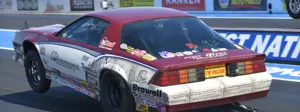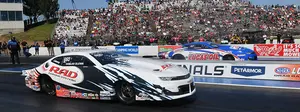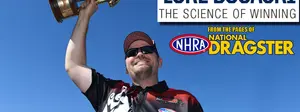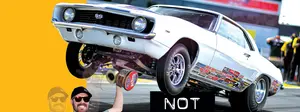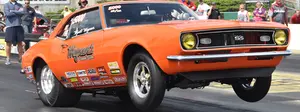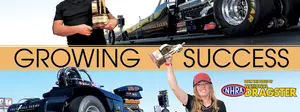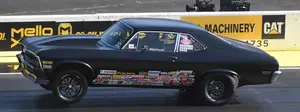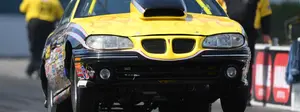

The Science of Winning: The Pointless Nature of Staging Battles

Staging battles have been around since the advent of the automated Christmas Tree, perhaps even before. In a recent edition of the popular “Nitro Time Machine” on NHRA social media, Brian Lohnes relived a great Pro Stock burndown between Larry Morgan and Allen Johnson in the 2015 Denver final round. In her recent book, Drag Racing’s Warren “The Professor” Johnson, Kelly Wade recounted another Denver Pro Stock finale, from a decade earlier: in 2005, Warren Johnson and Dave Connolly had a memorable burndown, after which WJ famously quipped that he “taught that punk a lesson.” Perhaps you can recall another epic staging battle or two!
Whether in the Professional categories or the Sportsman ranks, staging battles, while not necessarily commonplace, are a constant source of entertainment. That’s a commonly shared opinion. Here’s another opinion that isn’t nearly as popular: staging battles are pointless.
Seriously, they serve no purpose. Zero.
As a competitor, here’s the deal …
The race cannot begin until all four stage bulbs (pre-stage and stage, for both lanes) are illuminated. And the order in which they light up has absolutely no impact on the outcome of the round of competition. None.
If that sounds oversimplified, well, that’s my point! Many — perhaps most — racers have a staging preference. We’re more comfortable staging first, “I like to get in and get set,” or last, “The race starts when I say so.” I’d argue that either preference is both silly and ultimately flawed. Whether we prefer to stage first or last, eventually — inevitably — a situation will present itself in which we’re unable to do so reasonably. What happens at that point is that we’ve created a disadvantage for ourselves because we view the opposite of our own staging preference as a hurdle. A hurdle that, to be clear, is 100% self-induced!
My advice is simple: get comfortable staging first, and get comfortable staging last. Convince yourself that it doesn’t matter (because, guess what? It doesn’t matter). One simple trick for those of you racing with a transbrake (whether off the bottom bulb or with a delay box) is this: whether you stage first or second, only set the transbrake once both cars have staged. When we stage last, this is obvious. When we stage first, simply hold the car in the beams with the brake pedal and wait to engage the transbrake until both cars have staged. This eliminates the perception that you’re staged forever, building up physical and emotional tension while waiting on the Tree. This practice also allows us to take full advantage of AutoStart … but more on that later.
“But,” you say, “what if I know that my opponent wants to stage first? I should rush up there and stage to exploit that tendency, right?” Nah.
I tend to look at it like this. I don’t know of a single elite competitor who truly believes that they’re incapable of winning a round when staging first or last. The top racers know that it just doesn’t matter. So, if I truly believe that I can get my opponent out of his or her comfort zone by staging quickly or slowly, to the point that it will impact their performance … well, I would argue that my opponent has such a fragile psyche that I should beat him or her anyhow. Why do I need to play some silly game? Conversely, if I truly think my opponent is a savvy, worthy competitor, then I know that staging first or last isn’t going to impact their performance. So again, what’s the point?
Earlier, I referenced AutoStart, a function of the timing system that was introduced a little more than two decades ago. While AutoStart was implemented to remove human error by automating the firing of the Tree at a consistent interval once both cars stage, it also served to eliminate (or at least significantly decrease) the somewhat common practice of “hanging” an opponent out. With AutoStart, once one driver is fully staged (and the other lane is pre-staged), the opposing driver has seven seconds to get staged (in NHRA Lucas Oil Drag Racing Series and NHRA Camping World Drag Racing Series competition. The timeout is typically longer at bracket events). If they aren’t staged in that timeframe, it’s an automatic red-light and disqualification.
More recently, a growing number of competitors — some call them savvy, some call them dirty (I’ll leave that up to you) — have found ways to manipulate the AutoStart system. The most common practice is this: said racer will inch into the stage beams ever so gently and light their stage bulb briefly before turning it back out (a number of different tactics can be employed to do this — it’s not as difficult as it may sound). Once the three lights (pre-stage for both lanes as well as stage in the other) on the Tree have been lit for .6 seconds continuously, the timeout process begins. At this point, neither driver is staged, but both lanes are on the clock. With a full understanding of the intricacies of the timing system, the racer who instigated this process has the countdown in his or her head. While I believe that the intention is typically to simply force their opponent to stage first, occasionally a stubborn (and ignorant or perhaps oblivious) opponent refuses to do so. After five to six seconds (in the event of a seven-second timeout) have passed, said racer lights their stage bulb fully (they know that they’ll be disqualified if they do not). Shortly thereafter, the other lane is timed out. The result is an automatic red-light for the unsuspecting, but complicit late stager, and a free win light for the racer employing the shenanigans and taking full advantage of the current rules.
In this situation, both lanes are complicit. Had either racer been willing to stage first, all of this mess would have been avoided. Is it fair for the savvy/dirty racer to dictate that? Perhaps not. But it’s not outside of the current rule structure.
Let’s circle back to my earlier point … As long as we’re willing to stage first or last, none of this matters! If you’re looking for a mental construct, a template if you will, to employ in your racing, I’ll share my own. I’ve got a very regimented routine for staging. I take my time. Some would say that I’m slow to stage; I would argue that I’m precise! Regardless, my routine is longer than most, so I tend to stage second more often than I stage first. But my routine is my routine. If you started a stopwatch at the time that both cars pre-stage in 10 of my runs and stop it when I light my stage bulb, I’d be willing to bet that the time would be within a second or two every single round. Sometimes I stage first, sometimes I stage last. It doesn’t matter to me. In fact, when asked about it after the run, I often can’t even remember if I went in first or second. That simple process has served me well, and I would argue that it’s the most practical and effective approach.























